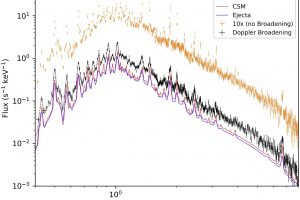Simulate le osservazioni XRISM dell’iconico resto di supernova SN1987 A. L’articolo: “Probing Shocked Ejecta in SN 1987A: A novel diagnostic approach using XRISM−Resolve” di V. Sapienza (UNIPA/OAPA) presto pubblicate su ApJL

SN1987 A è uno degli oggetti più importanti nello studio delle supernove e dei resti di supernova. Si tratta infatti dell’unica esplosione di supernova per collasso del nucleo (core-collapse supernova) avvenuta a distanze relativamente vicine (circa 170000 anni luce, nella Grande Nube di Magellano) in epoca moderna. È l’unico evento nell’Universo per il quale disponiamo di osservazioni dirette tramite telescopio della stella progenitrice, della supernova stessa e del resto di supernova. SN1987 A viene inoltre costantemente monitorato in diverse bande dello spettro elettromagnetico per osservarne e studiarne l’evoluzione.
La produzione di emissione di raggi X risulta particolarmente interessante poiché consente di seguire l’evoluzione dei fenomeni ad alta energia del materiale investito dalle onde d’urto in SN1987 A. Sei mesi dopo l’esplosione (avvenuta il 23 febbraio 1987), l’emissione di raggi X ad alta energia (10-30 keV) è stata individuata grazie alle osservazioni effettuate con il satellite per osservazioni ai raggi X Ginga. Poco più di quattro anni dopo l’esplosione, osservazioni condotte con il satellite ROSAT hanno permesso di individuare emissione di raggi X a energia più bassa (0.1-2.4 keV).
Complessivamente, nel corso degli anni, l’emissione di raggi X da SN1987 A è sempre aumentata, anche se negli ultimi anni si è notata una diminuzione nell’emissione di raggi X nella banda a energia più bassa. Dettagliate simulazioni magnetoidrodinamiche tridimensionali, sviluppate dagli astronomi del nostro Osservatorio, che hanno riprodotto l’evoluzione complessiva del resto di supernova, hanno dimostrato che l’evoluzione di SN1987 A si può dividere in tre distinti momenti: in una prima fase, l’emissione di raggi X era dominata dalla nube di gas attorno alla progenitrice, investita dall’onda d’urto generata dalla supernova; in una seconda fase, l’onda d’urto ha raggiunto una densa nube circumstellare, formata dalla stella durante i suoi ultimi stadi evolutivi, caratterizzata da una morfologia ad anello. In una terza fase, ci si aspetta di osservare l’emissione derivante dai frammenti espulsi dalla supernova (gli ejecta), colpiti dall’onda d’urto inversa generata dalla riflessione dell’onda d’urto sul mezzo circumstellare denso.
SN1987 A sarà oggetto di osservazioni tramite il satellite XRISM dell’Agenzia Spaziale Giapponese (JAXA) e della NASA. Grazie al suo spettrografo rivoluzionario ad altissima risoluzione spettrale, XRISM consentirà di risolvere i contributi di emissione legati ai diversi elementi chimici presenti in SN1987 A e alle sue varie componenti dinamiche con una precisione senza precedenti. Le potenzialità delle osservazioni spettroscopiche di XRISM sui resti di supernova, in particolare il resto N132D, sono state recentemente divulgate (link).
Per preparare la comunità scientifica alle innovative osservazioni di XRISM di SN1987 A, il team guidato da V. Sapienza (Università degli Studi di Palermo ed INAF – Osservatorio Astronomico di Palermo) ha sintetizzato osservazioni spettroscopiche di circa 28 ore con XRISM (la stessa durata dell’osservazione pianificate come parte della fase di “performance verification”), basandosi sui modelli esistenti di SN1987 A. Come previsto, i risultati sono sorprendenti: XRISM sarà in grado di risolvere l’allargamento delle righe spettrali, prodotte da ioni di elementi pesanti come silicio e magnesio altamente ionizzati, a causa dell’effetto Doppler indotto dal movimento degli ejecta all’interno del resto di supernova con velocità superiori ai 3000 km/sec. Inoltre, come previsto dai modelli, sarà possibile per la prima volta osservare l’emissione di raggi X prodotta dagli ejecta.
Questi risultati, descritti nella lettera: “Probing Shocked Ejecta in SN 1987A: A novel diagnostic approach using XRISM-Resolve” accettata per la pubblicazione su “The Astrophysical Journal Letters”, dimostrano le notevoli capacità di XRISM nel fornire una profonda comprensione dei processi fisici ed evolutivi in SN1987 A e, più in generale, nei resti di supernova. Allo studio hanno partecipato anche gli astronomi F. Bocchino e S. Orlando dell’INAF – Osservatorio Astronomico di Palermo, e M. Miceli e R. Giuffrida dell’Università degli Studi di Palermo (associati INAF).
La figura di copertina (clicca qui per visualizzarla interamente) illustra lo spettro sintetico XRISM di SN1987 A, ottenuto in questo studio. Lo spettro nero comprende tutte le componenti fisiche e dinamiche considerate nello studio. Lo spettro arancione, spostato verso l’alto per migliorare la visualizzazione, non include gli effetti derivanti dalla dinamica del materiale e alcuni effetti strumentali. La curva rossa rappresenta lo spettro generato dal mezzo circumstellare investito dall’onda d’urto, mentre nella curva blu è isolato il contributo degli ejecta.
Mario Giuseppe Guarcello ( segui mariospiegacose) ( mariospiegacose)( follow mariospiegacose)
Segui la pagina Facebook e Instagram dell’Osservatorio Astronomico di Palermo
Iscriviti al canale Youtube dell’Osservatorio Astronomico di Palermo
